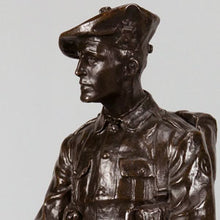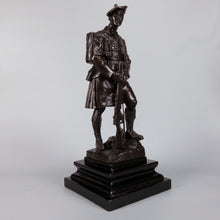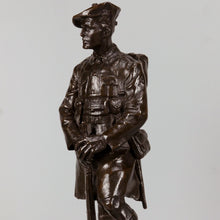Soldier of the 51st Highland Division
Adding product to your cart
Overall height: 48.5cm (19.2in)
Patinated bronze. Standing figure modelled as a First World War kilted Highlander in field service order, comprising Tam O’Shanter, Pattern 1902 Tunic with Pattern 1908 web equipment, No.1 Mk.III Enfield rifle, knee socks, ankle puttees and Ammo boots. Signed ‘G.H. Paulin, 1924’ on the integral square base. Height on bronze 41cm (16in).
The present bronze is a period reduced scale model of the 51st (Highland) Division Memorial at Beaumont-Hamel that commemorates the fallen of the division in two World Wars. The memorial stands on the site of a formidable defensive position taken by the division on 13 November 1916 during the Battle of the Ancre in the closing stage of the Battle of the Somme. The kilted highlander, created by the Scottish sculptor George Henry Paulin, was modelled on Company Sergeant Major Rowan, DCM, of the Glasgow Highlanders (1/9th Highland Light Infantry). The face, however, is that of Paulin's brother, Charles Ross Paulin, who was a 2nd Lieutenant in the Indian Army Reserve of Officers, and an Assistant Inspector in the Indian Police. He died at Lucknow in 1916.
Read more

The 51st (Highland) Division was raised in 1908 as a formation of the newly raised Territorial Force. Its battalions were brigaded on regimental lines - the Seaforth and Cameron Brigade, the Gordon Highlanders Brigade and the Argyll and Sutherland Highlanders Brigade - but following mass casualties on the Western Front from 1914 onwards the division was plundered by the Regular Army requiring reinforcement in France. By early 1915, the Highland Division had lost six of its 12 pre-war TF battalions. When TF divisions were finally ordered overseas as complete formations in their own right in early 1915, the Highland Division was only at half-strength. Last-minute additions permitted its deployment in May to help stem the German onslaught of the Second Battle of Ypres, but its performance was considered unimpressive, - ‘practically untrained and very green in all field duties’, according to Douglas Haig. The situation was resolved in January 1916, when the original TF Highland battalions were released by the regular divisions and by the addition of battalions of Black Watch (Royal Highlanders).
Given the chance to show their mettle in July 1916, during the Battle of the Somme, the 51st Highland Division assaulted High Wood, which it attacked forcefully in the midst of a murderous field of fire without shelter. Though they failed to take the position, they had shown the fighting spirit expected of Highlanders. The division's reputation grew and they were chosen to capture the notorious fortress village of Beaumont-Hamel in November 1916, towards the end of the Somme offensive. By 1917, the 51st was considered a leading assault division and was handed more and more difficult tasks, throughout the year, from Arras in April/May to the combined tank-infantry assault at Cambrai in November.
By early 1918, the formation was below-strength due to losses and the survivors were withdrawn to a quiet sector of the line. Unfortunately, the Germans had chosen that sector as one of the focal points for the Kaiserschlacht, the last great German assault on the west in March 1918, intended to win the war before the American Expeditionary Force could arrive in great numbers. The 51st Highland Division was pushed back, but eventually held as the German offensive ebbed and flowed. The remains of the division survived the spring battles and received replacements in time for the final Allied offensives that concluded with the Armistice of 11 November 1918.
George Henry Paulin (1888-1962), was a son of the manse. He was educated at Dollar Academy, and trained at the Edinburgh College of Art. He attended L'Ecole des Beaux Arts in Paris on a travelling scholarship and afterwards ran a studio in Florence. On the outbreak of war in 1914, he returned to Scotland and enlisted in the Lothians and Border Horse before obtaining a commission in the Royal Flying Corps. He served on the Italian front and was involved in intelligence work. In 1919, he set up a studio in Buccleuch Street in Glasgow. His figure of the seated warrior for the Kirkcudbright war memorial won acclaim and led to further war memorial commissions, principally the 51st (Highland) Division memorial on Newfoundland's Field of Remembrance at Beaumont-Hamel. He also responsible for the Celtic cross memorial to the 8th Battalion Argyll and Sutherland Highlanders nearby. His growing reputation brought him the commission for a headstone for the Scottish-American industrialist and philanthropist Andrew Carnegie in New York. He was elected a member of the Royal Scottish Academy (1920); Fellow of the Royal Society of British Sculptors (1938); and appointed official representative of the Royal Scottish Academy in London (1927-57). In 1935, he was commissioned by the Royal Academy of Arts to create a series of 22 busts of past presidents.

During the Second World War Paulin volunteered his services to a Glasgow munitions factory, specialising in precision engineering. Meanwhile in London, his studio was destroyed icy enemy action. In 1945 he was commissioned by the United States Navy to create a monument to John Paul Jones the founder of the American Navy, in his home town of Kirkbean near Dumfries. Another commission of public note was the Royal Coat of Arms added as a ceiling boss of St. George's Chapel in Westminster Abbey. This sculpture was painted by the portrait painter Frank O. Salisbury, RA. In the coronation year of 1953, Paulin’s career reached new heights with royal commissions for the depiction of a monarch's head for use as a hallmark, and busts of both the Queen and Prince Philip. As a result of the publicity, he received another wave of private commissions. In 1956, he received a second royal commission for a life-size bust of Queen Elizabeth II for display in the Royal Scottish Academy.








